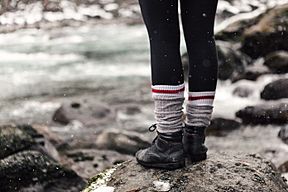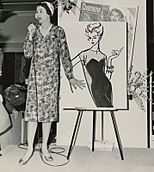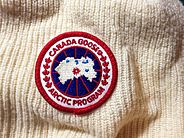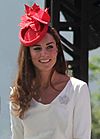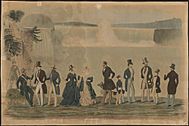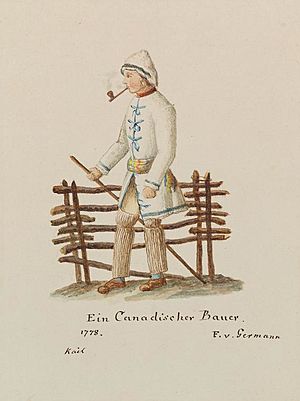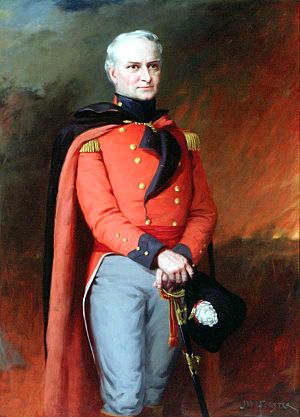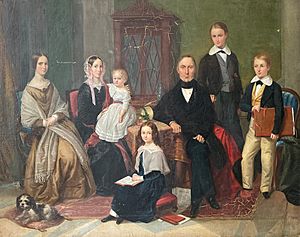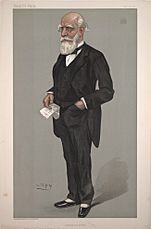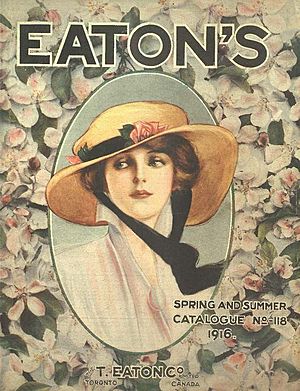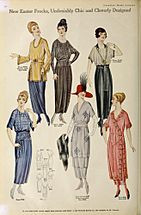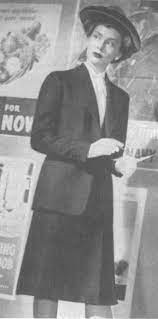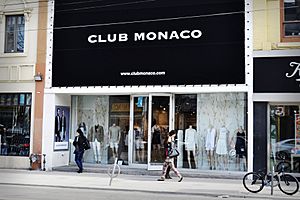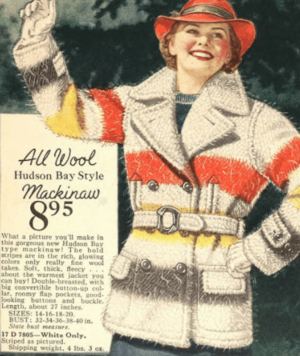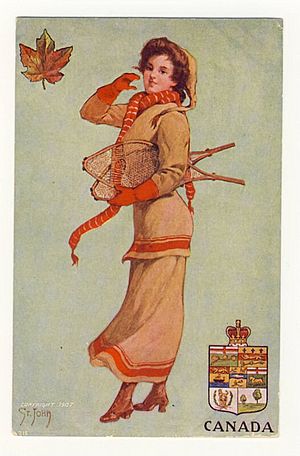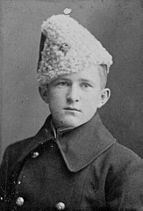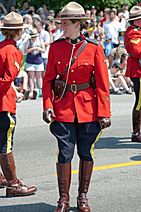Canadian fashion facts for kids
Canadian fashion is all about the clothes, shoes, and accessories people wear in Canada. It includes how things are designed and made. Fashion in Canada has changed a lot over time.
For thousands of years, Indigenous peoples created clothing for daily life and special ceremonies. Their styles were unique to each culture. When Europeans arrived in the 16th century, they brought their own fashions. These styles often changed to fit Canada's cold weather and rugged land.
Canada's fashion history shows different styles from different times. These styles were often influenced by fashion in Britain and France. But they also adapted to life in Canada.
Today, Canada has many clothing brands like Arc'teryx and Lululemon. There are also big stores like Hudson’s Bay Company and Holt Renfrew. Major cities like Toronto and Montreal host fashion events. You can also find Canadian fashion magazines and schools for fashion design.
How Canadian Fashion Has Changed
Early Days and the Fur Trade (1530s to 1750s)
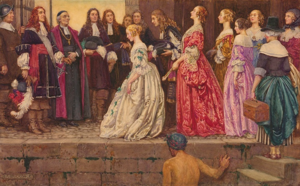
The fur trade was very important in early Canada. People hunted animals like beavers for their fur. This fur was then sent to Europe. This trade helped create new settlements across Canada.
Capotes were long wool coats with hoods. Both Europeans and Indigenous peoples wore them. They were easy to move in and kept people warm. The Hudson's Bay Company sold these coats, often made from their special "point blanket."
Europeans also started wearing mukluks. These were hide boots first made by Inuit people. Mukluks were warm and easy to walk in, especially in snowy areas. Europeans learned from Indigenous designs. This also led to new styles and materials in Indigenous clothing.
Most people in New France were farmers and fishers called habitants. Their clothes were usually homemade from linen, hemp, or wool. Men wore shirts, breeches, and wool stockings. Women wore cotton shifts, wool skirts, and bonnets. Their clothes were simple and practical.
Richer people in New France wore fancier clothes. They used fine fabrics like silk and velvet. Men often wore wigs and hats with feathers. Women wore decorative blouses with lace and pleated skirts.
The wealthiest people, the nobility, wore even more luxurious clothes. Their outfits had gold and silver threads and floral designs. Dresses often had long trains, with the length showing how important someone was.
After New France and British Influence (1760s to 1800s)
After the British took over New France, fashion slowly changed. Richer Canadian women started to wear styles popular in Europe. These included lace, ruffles, and pastel colors. English styles were more common in areas with many British settlers. English-Canadian dresses were often simpler than French ones.
Men's fashion became more casual and sleek. Three-piece suits became more common. Clothes became tighter over time.
Regency Era (1810s to 1830s)
Many people from the British Isles moved to Canada during this time. This brought London fashion to Canada. Even in French-speaking areas, new styles became popular. People spent more money on clothes.
The "dandy" style was popular for men. It included dark colors, blue tailcoats with gold buttons, and white shirts. Trousers replaced breeches. Men also wore tall black hats, ties, and gloves.
Women's fashion became more dramatic. Dresses had puffy sleeves, bell-shaped skirts, and fancy hats. Empire dresses were popular early on, with a high waist and loose bottom. Later, sleeves became very large.
The mackinaw jacket was invented during the War of 1812. Soldiers needed warm, shorter coats for winter travel. They used wool blankets, including some with a red and black pattern, to make these jackets.
Confederation Era (1840s to 1890s)
Women's everyday fashion in this era was very varied and decorative. Dresses in the 1830s were wide and full. By the 1850s, crinoline skirts (which made skirts very wide) were popular. Later, dresses became more fitted, like an "hourglass" shape. Women often changed their old clothes to keep up with new trends.
Formal wear was important for Canadian women. They enjoyed costume theatre, skating events, and balls. People often dressed as historical figures like Marie Antoinette. They tried to be historically accurate but also fashionable.
Outerwear also changed. When crinoline skirts were popular, women wore shawls instead of coats. Hats and bonnets became very popular in the 1880s and 90s. They were decorated with ribbons, lace, flowers, and feathers.
As Canada's middle class grew, professional clothing became important. Men's fashion became simpler, with black suits. Wealthy men had custom-made suits. But cheaper, ready-made suits became available through mail-order catalogs. Fur coats were common in winter.
Men added personal style with accessories like pocket watches, ties, and top hats.
Leisure and club wear also became popular. People needed special clothes for activities like hockey, horseback riding, and cycling. Breeches were popular for riding. Fraternal groups like the Freemasons wore special ceremonial clothes.
Local clothing industries grew in the mid-1800s. Dressmakers and tailors opened shops in cities like Toronto and Montreal. They made custom clothes and sold fabrics. Designers started using labels to show their work. Department stores began selling designer clothes alongside ready-made items.
Early 20th Century and World Wars (1900s to 1950s)
In the early 1900s, Parisian fashion greatly influenced Western styles, including in Canada. Mass-produced clothing became more common. This made it harder for local custom tailors. However, some Canadian designers became well-known. Department stores like Eaton's and Simpson's sold both imported and Canadian designs.
Military uniforms changed from bright colors to more practical "service dress" jackets. These jackets were used for both field duty and formal wear.
The fight for women’s rights and more women in sports changed fashion. In the 1920s, women's clothes became more comfortable. Trousers and shorter skirts became popular. The "flapper" style, with shift dresses and loose fits, was also popular. Corsets were replaced by simpler lingerie.
Men's suits also became less formal. Shorter jackets replaced long ones for everyday wear. Trousers became narrower, then wider later in the decade. Men's hats often showed their social class.
During World War II, fashion changed a lot. Fabrics and metals were needed for the war effort. Practical clothing was encouraged. Women took on jobs usually done by men. Their fashion reflected these new roles. Simpler styles, colors, and designs were common.
Despite restrictions, fashion continued. Magazines and newspapers still showed new designs and talked about trends. Women's suits became a popular "Canadian tradition." Women also started wearing slacks, which were usually for men.
After the war, department store catalogs like Eaton's and Simpson's were very important. They helped spread ready-to-wear fashion. Dresses became tighter at the top and fuller at the bottom. Corsets and girdles returned to fashion. Catalogs also promoted youth as the ideal beauty standard.
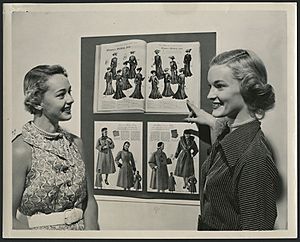
The Hudson's Bay Company expanded its department stores across Canada. Holt Renfrew also grew, partnering with famous French and Italian fashion houses like Christian Dior. By 1958, most women's clothing sold in Canada was made in Canada.
In 1954, the Association of Canadian Couturiers was formed. It aimed to promote Canadian design internationally. They held fashion shows in Canada and New York.
Late 20th Century (1960s to 1990s)
In 1974, the Fashion Designers Association of Canada was founded. It promoted Canadian designers and the fashion industry. Designers like Michel Robichaud and Marielle Fleury became famous worldwide.
Canadian fashion designers gained more international recognition in these decades. Famous names include Alfred Sung (who co-founded Club Monaco), Jean-Claude Poitras, and Linda Lundstrom. The Fashion Design Council of Canada was founded later to support the industry.
Many popular Canadian brands started in the late 20th century. These include Sorel and Roots from Ontario. From Quebec came Aldo and Ardene. British Columbia gave us Aritzia, Arc'teryx, and Lululemon.
Canadian Fashion Styles
Canadian fashion often reflects the country's history and different lifestyles. For example, "athleisure" (athletic and leisure wear) is very popular. The "blanket jacket," a modern version of old capotes and Mackinaw jackets, is seen as a national costume. Brands like Aritzia and Simons take inspiration from it. Lululemon and Roots have also made innovations in leggings and sweatsuits.
The parka is another traditional functional garment. It comes from Indigenous cultures in Northern Canada. Now, brands like Canada Goose sell parkas as high-end urban wear.
Canada is also known for its winter boots. Companies have created warm, waterproof boots that are also stylish. Examples include "cougar pillow" boots and Sorel's cold-weather boots.
Many types of headwear have cultural meaning in Canada. Beaver hats were important for the fur trade. The Calgary white hat symbolizes Calgary's ranching culture. The beanie (knitted cap) is also a well-known Canadian item. Other Canadian hats include the Tilley hat and the "Pang" hat.
Equestrian (horse riding) styles have influenced modern Canadian fashion. Blazers, tall leather boots, and plaid jackets are popular. Brands like Smythe and Aldo use these elements. Smythe blazers became famous when the Princess of Wales wore them.
Uniforms
Public Service Uniforms
One of Canada's most famous uniforms is worn by the Royal Canadian Mounted Police (RCMP). It includes the Red Serge, a bright red jacket with a black collar. They also wear dark blue pants with yellow stripes, brown boots, and a brown felt "stetson" hat.
The fur wedge cap is a traditional hat for some Canadian police forces and the Canadian Armed Forces. It was used from the 1890s to the 1970s. Officer cadets at the Royal Military College of Canada still wear it. The cap is often made from synthetic fur or animal wool.


